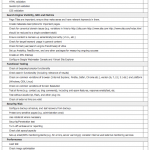There is a fantastic Website Checklist over at the Box UK blog site, which I’ve copied into a simple image here.
[fusion_builder_container hundred_percent=”yes” overflow=”visible”][fusion_builder_row][fusion_builder_column type=”1_1″ background_position=”left top” background_color=”” border_size=”” border_color=”” border_style=”solid” spacing=”yes” background_image=”” background_repeat=”no-repeat” padding=”” margin_top=”0px” margin_bottom=”0px” class=”” id=”” animation_type=”” animation_speed=”0.3″ animation_direction=”left” hide_on_mobile=”no” center_content=”no” min_height=”none”]
It’s funny, I’ve worked with close to 100 companies on their websites and web applications to one degree or another, and none of them have had a checklist like this. Sure, they have test plans, but those are primarily functional tests, not a thorough examination of so many areas.
I highly recommend using this list, or a variant of this list, for your web sites and web applications. It’s important whether you’re a single person putting up a small static site, or a Fortune 100 working on a huge eCommerce application. Using a checklist will ensure you don’t miss out on a simple step or check before going live.
A couple highlights I want to call out are:
“Spelling and grammar, Tense/style of writing” and other copywriting and editing type checks. This is an area that is typically neglected by web organizations. Let’s be honest, while many tech folks can communicate well (in contrast to the sometimes true stereotypes), we aren’t English majors. Also, even if you are an English major, you know how important having someone else check over your work is. Another advantage to having a 3rd party review your text, is that they can provide valuable insight into how the web audience in general will read and understand your content. If you’ve been living and breathing your business or technology for the past three months, you’ll subconsciously make assumptions about the website reader or web application user. Assumptions about what terms they’ll understand, how well they understand your application’s features and flow, and much more. Getting a 3rd party, or optimally multiple 3rd parties, to provide input on your site’s text and flow can be very beneficial.
Getting your text reviewed by a professional editor doesn’t have to be expensive or time consuming. The average rate for editors is $40/hour, and many editors can review and provide feedback for your entire site in just a few hours. Many of them also can turn around the whole job within a couple of days, or less, of you contacting them. So for less than $200 you can dramatically improve how you communicate with your visitors and users. This leads to better perception of your site, and better usage statistics.
Currently Jasmine Young Editing is offering an unpublished special for referencable clients (up to 50% off, depending on the job). I’ve used Jasmine Young for several sites and white-papers and have found her skills to be invaluable. I consider myself a decent writer, but she is always able to dramatically improve my content. She also has very fast turn around times, which is great for those moments when I’m dying to get something published online.
“Configure backup schedule, and test recovery from backup”. It’s a classic mistake to either put off setting up a backup system, or to set one up without testing the recovery half of the process. The popular bookmarking site Ma.gnolia recently lost it’s entire database, and was unable to recover from backups. This is important, and pretty easy to setup. Don’t forget, and don’t put it off.
What else would you put on your list?[/fusion_builder_column][/fusion_builder_row][/fusion_builder_container]
Leave a Reply